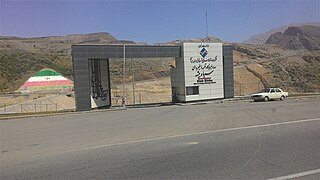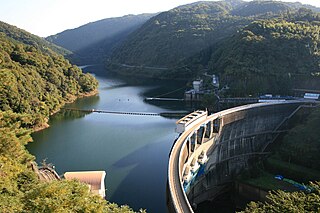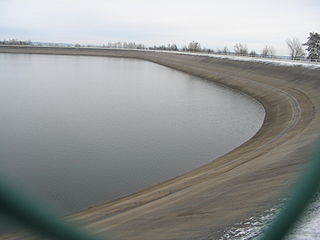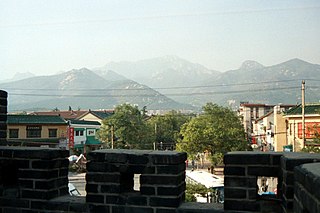
Tanbara Dam is a rock-fill embankment dam on a Tone River tributary in Gunma Prefecture of Japan. It is located 14 kilometres (8.7 mi) north of Numata. It creates the upper reservoir for the 1,200 megawatts (1,600,000 hp) Tamahara Pumped Storage Power Station (玉原発電所). Construction began in 1973 and the dam was complete in 1981 while the power station was commissioned in 1986. It is 116 metres (381 ft) tall and withholds a reservoir with a storage capacity of 14,800,000 m3 (11,999 acre⋅ft). Of that capacity, 13,000,000 cubic metres (11,000 acre⋅ft) is active for power generation. The lower reservoir for the pumped-storage power station is created by the Fujiwara Dam, located 4 km (2 mi) to the northwest on another Tone River tributary. Power is generated during periods of high energy demand and pumping occurs during times when energy demand is low such as at night. The power station contains four 300 megawatts (400,000 hp) reversible Francis turbine pump-generators which serve to both pump water and generate electricity. The upper Tamahara Reservoir is at an elevation of 1,177 metres (3,862 ft) and the lower Fujiwara Reservoir is at 651 metres (2,136 ft) which affords the power station an effective hydraulic head of 518 metres (1,699 ft). When pumping, the pump-generators can move up to 210 cubic metres per second (7,400 cu ft/s) of water and when generating, they discharge up to 276 cubic metres per second (9,700 cu ft/s).

The Siah Bisheh Pumped Storage Power Plant, also spelled Siyāhbisheh and Siah Bishe, is located in the Alborz Mountain range near the village of Siah Bisheh and 48 km (30 mi) south of Chalus in Mazandaran Province, Iran. The power plant uses the pumped-storage hydroelectric method to generate electricity during periods of high energy demand, making it a peaking power plant, intended to fulfill peak electricity demand in Tehran 60 km (37 mi) to the south. When complete it will have an installed generating capacity of 1,040 megawatts (1,390,000 hp) and a pumping capacity of 940 megawatts (1,260,000 hp). Planning for the project began in the 1970s and construction began in 1985. It was delayed from 1992 until 2001 and the first generator went online in May 2013. The remaining generators were commissioned by 1 September 2015. The power plant is the first pumped-storage type in Iran and will also use the country's first concrete-face rock-fill dam – two of them.

The Kannagawa Hydropower Plant (神流川発電所) is an under construction pumped-storage hydroelectric power plant near Minamiaiki in Nagano Prefecture and Ueno in Gunma Prefecture, Japan. The power plant utilizes the Minamiaiki River along with an upper and lower reservoir created by two dams, the upper Minamiaiki Dam and the lower Ueno Dam. The power station in between the two dams will contain six 470 megawatts (630,000 hp) pump-generators for a total installed capacity of 2,820 megawatts (3,780,000 hp). Unit 1 commenced commercial operation in 2005 and Unit 2 in 2012. When completed, the plant will have the second-largest pumped-storage power capacity in the world.

The Amagase Dam (天ヶ瀬ダム) is an arch dam on the Uji River just upstream from Uji, Kyoto Prefecture, Japan. The main purpose of the dam is flood control but it supports a hydroelectric power station and creates the lower reservoir for the Kisenyama Pumped Storage Plant. The dam itself serves a 92 MW power station while the pumped-storage power station upstream has a 466 MW capacity. Construction on the dam began in 1955 and it was complete in 1964. The pumped-storage power station became operational in 1970. Both plants are owned by Kansai Electric Power Company.

The Coo-Trois-Ponts Hydroelectric Power Station is a pumped-storage hydroelectric power station located in Trois-Ponts, Province of Liege, Belgium. Located next to the Amblève River, the power station uses its water to support a power scheme where water is pumped from a lower reservoir to one of two upper reservoirs known as Coo I and Coo II. When energy demand is high, water can be released from these reservoirs for power generation. The water then returns to the lower reservoir and the process repeats as needed. The same machines that pump the water to the upper reservoirs at a higher elevation are also used as generators. The plant was commissioned in two stages, Coo I (1969) and Coo II (1978). It is owned by Electrabel and has an installed capacity of 1,164 MW.
The Hohhot Pumped Storage Power Station, also known by Huhehaote, is located 20 kilometres (12 mi) north of Hohhot in Inner Mongolia, China. It uses the pumped-storage hydroelectric method to generate electricity. The plant has an installed capacity of 1,224 megawatts (1,641,000 hp). Construction began in 2005 and the first generator was commissioned on 20 November 2014. The second generator was commissioned on 26 December 2014 and the final two were commissioned in June 2015.
The Jixi Pumped Storage Power Station is a pumped-storage hydroelectric power station currently under construction in Jixi County, Anhui Province, China. Studies were carried out in 2008 and construction began in December 2010. It is expected to last 6 years. As of April 2017 the dam is completed.
The Liyang Pumped Storage Power Station is a pumped-storage hydroelectric power station 22 km (14 mi) south of Liyang in Jiangsu Province, eastern China. Preliminary construction began in 2002 and major works started in May 2011. The first unit of the power station was commissioned in 2017, the power station will have an installed capacity of 1,500 MW.
The Pushihe Pumped Storage Power Station is a pumped-storage hydroelectric power station located 54 km (34 mi) northeast of Dandong in Kuandian County of Liaoning Province, China. It was constructed between August 2006 and September 2012. The power station operates by shifting water between an upper and lower reservoir to generate electricity. The lower reservoir was formed with the creation of the Pushihe Lower Dam on the Pushihe River, a tributary of the Yalu River. The Pushihe Upper Reservoir is located in a valley above the east side of the lower reservoir. During periods of low energy demand, such as at night, water is pumped from Pushihe Lower Reservoir up to the upper reservoir. When energy demand is high, the water is released back down to the lower reservoir but the pump turbines that pumped the water up now reverse mode and serve as generators to produce electricity. The process is repeated as necessary and the plant serves as a peaking power plant.
The Xianyou Pumped Storage Power Station is a pumped-storage hydroelectric power station located 47 km (29 mi) west of Putian in Xianyou County of Fujian Province, China. Construction on the project began in May 2009 and the first generator was commissioned in April 2013, the last in December 2013. The power station operates by shifting water between an upper and lower reservoir to generate electricity. The lower reservoir was formed with the creation of the Xianyou Lower Dam on the Xikou River, a tributary of the Mulan River. The Xianyou Upper Reservoir is located in a valley above the east side of the lower reservoir on the Dajixi River, another tributary of the Mulan. During periods of low energy demand, such as at night, water is pumped from Xianyou Lower Reservoir up to the upper reservoir. When energy demand is high, the water is released back down to the lower reservoir but the pump turbines that pumped the water up now reverse mode and serve as generators to produce electricity. The process is repeated as necessary and the plant serves as a peaking power plant.
The Xilongchi Pumped Storage Power Station is a pumped-storage hydroelectric power station located 50 km (31 mi) east of Xinzhou in Wutai County of Shanxi Province, China. It was constructed between 2001 and 2008. The power station operates by shifting water between an upper and lower reservoir to generate electricity. The lower reservoir was formed with the creation of the Xilongchi Lower Dam. The Xilongchi Upper Reservoir is located high atop a mountain above the northeast side of the lower reservoir. Both reservoirs are located between the confluence of the Hutuo and Qingshui Rivers. During periods of low energy demand, such as at night, water is pumped from Xilongchi Lower Reservoir up to the upper reservoir. When energy demand is high, the water is released back down to the lower reservoir but the pump turbines that pumped the water up now reverse mode and serve as generators to produce electricity. The process is repeated as necessary and the plant serves as a peaking power plant.
The Xiangshuijian Pumped Storage Power Station is a pumped-storage hydroelectric power station located 29 kilometres (18 mi) southwest of Wuhu City in Sanshan District of Anhui Province, China. Construction on the power station began on 8 December 2006 and the upper reservoir dam was completed in October 2010. The first unit was commissioned on 1 December 2011 and the last on 17 November 2012. The power station operates by shifting water between an upper and lower reservoir to generate electricity. The lower reservoir was formed with the creation of the Xiangshuijian Lower Dam in a valley. The Xiangshuijian Upper Reservoir is in another valley above the west side of the lower reservoir. During periods of low energy demand, such as at night, water is pumped from Xiangshuijian Lower Reservoir up to the upper reservoir. When energy demand is high, the water is released back down to the lower reservoir but the pump turbines that pumped the water up now reverse mode and serve as generators to produce electricity. The process is repeated as necessary and the plant serves as a peaking power plant.
The Tongbai Pumped Storage Power Station is a pumped-storage hydroelectric power station located 6 kilometres (3.7 mi) north of Tiantai city in Tiantai County of Zhejiang Province, China. Construction on the power station began in May 2000 and the first unit was commissioned in December 2005. The remaining three were operational by December 2006. The entire project cost US$904.10 million, of which US$320 million was provided by the World Bank. The power station operates by shifting water between an upper and lower reservoir to generate electricity. The lower reservoir was formed with the creation of the Tongbai Lower Dam on the Baizhang River. The Tongbai Upper Reservoir, which already existed before construction began, is in an adjacent valley above the east side of the lower reservoir on Tongbai Creek. During periods of low energy demand, such as at night, water is pumped from Tongbai Lower Reservoir up to the upper reservoir. When energy demand is high, the water is released back down to the lower reservoir but the pump turbines that pumped the water up now reverse mode and serve as generators to produce electricity. The process is repeated as necessary and the plant serves as a peaking power plant. The power station is operated by Shenergy Company.
The Zhanghewan Pumped Storage Power Station is a pumped-storage hydroelectric power station located 50 km (31 mi) southwest of Shijiazhuang in Jingxing County of Hebei Province, China. Construction on the power station began on 6 December 2003 and the first unit was commissioned on 1 February 2009. The power station operates by shifting water between an upper and lower reservoir to generate electricity. The lower reservoir is created by the Zhanghewan Dam on the Gantao River which was built between 1977 and 1980, originally for irrigation. For this project the Zhanhewan Dam was raised 23 m (75 ft). The Zhanghewan Upper Reservoir is on Laoyemiao Mountain, above the west side of the lower reservoir. During periods of low energy demand, such as at night, water is pumped from Zhanghewan Lower Reservoir up to the upper reservoir. When energy demand is high, the water is released back down to the lower reservoir but the pump turbines that pumped the water up now reverse mode and serve as generators to produce electricity. The process is repeated as necessary and the plant serves as a peaking power plant.
The Fengning Pumped Storage Power Station is a pumped-storage hydroelectric power station currently under construction about 145 km (90 mi) northwest of Chengde in Fengning Manchu Autonomous County of Hebei Province, China. Construction on the power station began in June 2013 and the first generator is expected to be commissioned in 2019, the last in 2021. Project cost is US$1.87 billion. On 1 April 2014 Gezhouba Group was awarded the main contract to build the power station. It will be constructed in two 1,800 MW phases. When complete, it will be the largest pumped-storage power station in the world with an installed capacity of 3,600 MW. The power station will operate by shifting water between an upper and lower reservoir to generate electricity. During periods of low energy demand, such as at night, water will be pumped from Fengning Lower Reservoir up to the upper reservoir. When energy demand is high, the water is released back down to the lower reservoir but the pump turbines that pumped the water up now reverse mode and serve as generators to produce electricity. The process is repeated as necessary and the plant will serve as a peaking power plant.
The Yixing Pumped Storage Power Station is a pumped-storage hydroelectric power station located Yixing city of Jiangsu Province, China. Construction on the power station began in 2003 and the first unit was commissioned in 2007, the last in 2008. The entire project cost US$490 million, of which US$145 million was provided by the World Bank. The power station operates by shifting water between an upper and lower reservoir to generate electricity. The lower reservoir was formed with the existing Huiwu Dam at the foot of Mount Tongguan. The Yixing Upper Reservoir is located atop Mount Tongguan which peaks at 530 metres (1,740 ft) above sea level. During periods of low energy demand, such as at night, water is pumped from Huiwu Lower Reservoir up to the upper reservoir. When energy demand is high, the water is released back down to the lower reservoir but the pump turbines that pumped the water up now reverse mode and serve as generators to produce electricity. Water from the nearby Huangtong River can also be pumped into the lower reservoir to augment storage. The process is repeated as necessary and the plant serves as a peaking power plant. The power station is operated by East China Yixing Pumped Storage Co Ltd.
The Qingyuan Pumped Storage Power Station is a 1,280 MW pumped-storage hydroelectric power station about 20 km (12 mi) northwest of Qingyuan in Qingxin District, Guangdong Province, China. Construction on the project began in October 2008. Six workers were killed while excavating a tunnel on 19 November 2012. The upper reservoir began impounding water in March 2013 and the first generator and all four generators were commissioned by 30 November 2015.
The Hongping Pumped Storage Power Station is a 1,200 MW pumped-storage hydroelectric power station currently under construction about 11 km (6.8 mi) northwest of Hongping in Jing'an County of Jiangxi Province, China. Construction on the project began in June 2010. The first generator was commissioned in June 2014 and a second 1,200 MW phase is planned for completion in 2017. When fully operational, the power station will have an installed capacity of 2,400 MW. The power station operates by shifting water between an upper and lower reservoir to generate electricity. The lower reservoir is located on Hebei River and the upper reservoir is located in a valley above the north side of the lower reservoir. During periods of low energy demand, such as at night, water is pumped from Hongping Lower Reservoir up to the upper reservoir. When energy demand is high, the water is released back down to the lower reservoir but the pump turbines that pumped the water up now reverse mode and serve as generators to produce electricity. The process is repeated as necessary and the plant serves as a peaking power plant. It is operated by Jiangxi Hongping Pumped Storage Ltd.
The Huanggou Pumped Storage Power Station is a 1,200 MW pumped-storage hydroelectric power station currently under construction about 90 km (56 mi) north of Mudanjiang in Hailin County of Heilongjiang Province, China. Construction on the project began on 8 May 2014. The first generator is scheduled to be commissioned in January 2019 and the project complete in January 2020. The power station operates by shifting water between an upper and lower reservoir to generate electricity. The lower reservoir, Lianhua Reservoir, is located on the Mudan River and the upper reservoir is located in a valley above the north side of the lower reservoir. During periods of low energy demand, such as at night, water is pumped from Huanggou Lower Reservoir up to the upper reservoir. When energy demand is high, the water is released back down to the lower reservoir but the pump turbines that pumped the water up now reverse mode and serve as generators to produce electricity. The process is repeated as necessary and the plant serves as a peaking power plant. It is operated by the State Grid Corporation of China.

The Lianhua Dam is a concrete-face rock-fill dam on the Mudan River in Linkou County of Heilongjiang Province, China. It is located about 95 km (59 mi) north of Mudanjiang. The 71.8 m (236 ft) tall dam serves several purposes to include hydroelectric power generation, flood control and water supply for irrigation. The dam withholds a large 4,180,000,000 m3 (3,390,000 acre⋅ft) capacity reservoir and supports a 550 MW power station. Construction on the dam began in November 1992 and its first 137.5 MW Francis turbine-generator was operational in December 1996. Two more generators were commissioned on 12 December 1997 and the remaining generator was commissioned on 28 September 1998. It is the first large modern water conservancy project in Heilongjiang. The dam's reservoir displaced 40,000 people and will serve as the lower reservoir for the Huanggou Pumped Storage Power Station when it is complete.










